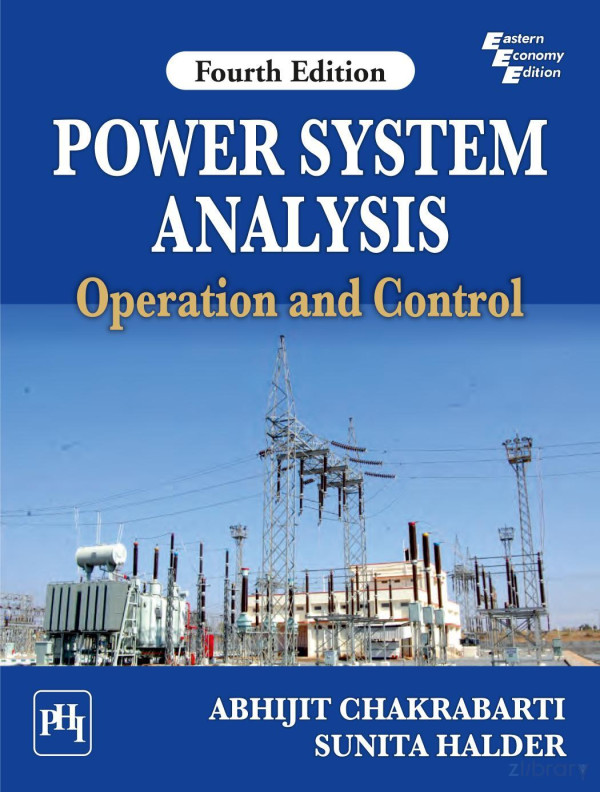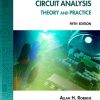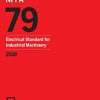Power System Analysis Operation and Control 4th Edition by Abhijit Chakrabarti, Sunita Halder 9391818005 9789391818005
$50.00 Original price was: $50.00.$35.00Current price is: $35.00.
Power System Analysis Operation and Control 4th Edition by Abhijit Chakrabarti, Sunita Halder – Ebook PDF Instant Download/Delivery: 9391818005, 9789391818005
Full download Power System Analysis Operation and Control 4th Edition after payment

Product details:
ISBN 10: 9391818005
ISBN 13: 9789391818005
Author: Abhijit Chakrabarti, Sunita Halder
This comprehensive textbook on Power System Analysis, now in its Fourth Edition, includes performance and operation of the system during steady-state and transient state besides the analytical modelling, planning and control aspects. With an emphasis on fundamental topics, the text attempts to illustrate the basic concepts in the practical field through numerical problems. Computer simulations have been added at suitable places. The treatments presented are exhaustive and elaborate.This book is designed to cover the power system courses in the senior undergraduate curriculum of electrical engineering. In the new edition, the chapters and corresponding examples are arranged to align with the up-to-date syllabus in the power system across the Institutes and Universities in India. Care is taken so that the model curriculum of AICTE is followed in the reconfigured presentations. Suitable problems/illustrations are included to prepare the students for the competitive examinations.
Table of contents:
Chapter 1: Introduction
1.1 Structure of a Power System
1.2 Power System Representation
1.2.1 Per Unit (P.U.) Representation
1.3 Power System at Normal Operating State
Exercises
Chapter 2: Electrical Energy Generation
2.1 Introduction
2.1.1 Electrical Energy and Power
2.2 Thermal Power Generation
2.2.1 Principal Flow Circuits
2.2.2 Principal Component of a Thermal Power Plant and their Use
2.3 Advantages and Disadvantages of Thermal Power Plant
2.3.1 Advantages
2.3.2 Disadvantages
2.4 Selection of Site for Thermal Power Plants
2.5 Hydroelectric Power Plants
2.5.1 Main Components of Hydroelectric Power Plant
2.6 Advantage and disadvantages of Hydroelectric Plants
2.6.1 Advantages
2.6.2 Disadvantages
2.7 Selection of Site for Hydroelectric Plants
2.8 Nuclear Power Generation
2.8.1 Principal Components of a Reactor
2.9 Advantages and Disadvantages of Nuclear Power Plant
2.9.1 Advantages
2.9.2 Disadvantages
2.10 Selection of Site for Nuclear Power Plants
2.11 Gas Turbine Plant
2.12 Renewable Energy Sources for Electricity Generation
2.12.1 Wind Energy
2.12.2 Solar Energy
2.12.3 Tidal Energy
2.12.4 Geothermal Energy
2.12.5 Biomass Energy
2.12.6 Magneto Hydrodynamic Electricity Generation (MHD)
2.13 Distributed Generation
2.14 Cogeneration
2.15 Commonly Used Terms
Exercises
Chapter 3: Transmission Line Parameters
3.1 Introduction
3.2 Conductors
3.3 Line Resistance
3.4 Skin Effect
3.5 Line Inductance
3.6 Inductance of a Conductor
3.6.1 Inductance of a Conductor Due to Internal Flux
3.6.2 Inductance of a Conductor Due to External Flux
3.7 Inductance of a Single Phase Two-wire Line
3.8 Inductance of Composite Conductor Lines
3.9 Inductance of Three Phase Lines
3.9.1 Symmetrical Spacing
3.9.2 Unsymmetrical Spacing and Transposition
3.10 Inductance of Double-Circuit Three Phase Lines
3.11 Computation of Inductance for Bundled Conductors
3.12 Potential Difference between Two Points Due to a Charge
3.13 Capacitance of a Two Wire Line (Line Capacitance)
3.14 Potential Difference between Two Conductor of a Group of Charged Conductor
3.15 Capacitance of Three Phase Lines
3.16 Charging Current Due to Capacitance
3.17 Effect of Earth on the Capacitance of Line
3.18 Capacitance of Three Phase Lines with More Than One Circuit
3.18.1 Capacitance of a Three Phase Double Circuit Line with Symmetrical Spacing
3.18.2 Capacitance of a Three Phase Double Circuit Line with Unsymmetrical Spacing (Thoroughly Transposed)
3.19 Capacitance of Bundled Conductors
Exercises
Chapter 4: Steady State Performance and Operation of Transmission Lines
4.1 Introduction
4.2 Characterisation of a Transmission Line
4.3 Types of Power Transmission Lines
4.4 Network Model for Transmission Line with Lumped Parameter Concept
4.5 Short Transmission Line Model
4.6 Voltage Regulation of a Short Line
4.7 Efficiency of Transmission for a Short Line
4.8 Representation of Medium Line
4.9 Long Transmission Line Model and Governing Equation
4.10 Evaluation of ABCD Constants
4.11 Equivalent Circuit of a Long Line
4.12 Ferranti Effect
4.13 Surge Impedance Loading (SIL)
4.14 Power Flow in Transmission Line
4.15 Power Circle Diagram
4.16 Reactive Power and Voltage Control in a Transmission Line
4.17 Reactive Power (VAR) Generators and Load Bus Voltage Compensation
4.18 Line Compensation
4.19 Shunt Compensation
4.20 Series Compensation
4.21 Shunt and Series Compensation Combined
Exercises
Chapter 5: Line Insulators
5.1 Introduction
5.2 Insulator Materials
5.2.1 Porcelain
5.2.2 Glass
5.2.3 Steatite
5.2.4 Composite Insulator
5.3 Types of Insulators
5.3.1 Pin Type Insulators
5.3.2 Suspension Type Insulators
5.3.3 Strain Type Insulators
5.3.4 Shackle Type Insulators
5.4 Potential Distribution over a String of Suspension Type Insulators
5.5 String efficiency (h)
5.6 Methods of Improving String Efficiency
5.6.1 Selection of a
5.6.2 Grading of Units
5.6.3 Guard Ring
5.7 Insulation Failure
5.8 Bushing
5.9 Testing of Insulators
5.10 Arcing Horn
Exercises
Chapter 6: Power Cables
6.1 Introduction
6.2 Types of Cables
6.2.1 Low Tension (LT) Cables
6.2.2 High Tension (HT) Cables
6.2.3 Super Tension (ST) Cables
6.2.4 Extra High Tension (EHT) Cables
6.3 General Construction of Power Cables
6.4 Advantages and Disadvantages of Underground Cables over Overhead Transmission Lines
6.5 Insulation Resistance of Power Cables
6.6 Capacitance and Insulation Stress in Cables
6.7 Sheathing and Grading in Cables
6.7.1 Use of Intersheaths
6.7.2 Capacitance Grading
6.8 Power Factor of Cables
6.9 Capacitance of a Three Phase Cable
6.10 Heating of Cables
6.10.1 Generation of Heat within the Cable
6.11 Breakdown of Cables
6.12 Selection of Cables
Exercises
Chapter 7: Mechanical Design of Overhead Lines
7.1 Introduction
7.2 Line Supports
7.2.1 Wooden Poles
7.2.2 Reinforced Concrete Poles
7.2.3 Tubular Steel Poles
7.2.4 Latticed Steel Towers
7.3 Conductor Materials
7.4 Calculation of Sag
7.4.1 Supports at Same Level
7.4.2 Supports at Different Levels
7.5 Stringing Chart
Exercises
Chapter 8: Corona
8.1 Mechanism of Corona
8.2 Concept of Electric Stress for Corona Discharge
8.3 Corona Discharge and Critical Voltages
8.4 Power Loss Due to Corona
8.5 Factors Affecting Corona Loss
8.6 Radio Interference of Corona
8.7 Methods of Reducing Corona
Exercises
Chapter 9: Transient Analysis and Wave Propagation in Transmission Lines
9.1 Introduction
9.2 Approximate Representation of a Transmission Line in Transient Study
9.3 Concept of Infinite Line
9.4 Expression of Characteristics Impedance of a Short Line in Terms of Open Circuit and Short Circuit Parameters
9.5 Propagation Constant, Attenuation Constant and Phase Shift Constants of Transmission Line
9.6 Wavelength and Velocity of Propagation
9.7 Differential Equation for the Propagation Waves in a Uniform Line
9.8 Evaluation of Surge Impedance
9.9 Velocity of Propagation of Travelling Waves
9.10 Analytical Expression for Voltage and Current of a Line at any Point of Length “X” from the Sending End
9.11 Reflection at Load
9.12 Reflection from Terminal Inductance
9.13 Reflection from Terminal Capacitance
9.14 Concept of Standing Wave and Voltage Standing Wave Ratio
9.15 Relation between VSWR and Reflection Coefficient K
9.16 Repeated Reflections—Bewley’s Lattice (Zigzag) Diagram
9.17 Reflection and Transmission at Junction of Two Dissimilar Lines
Exercises
Chapter 10: Load Flow Study
10.1 Introduction
10.2 Nodal Method for Development of [YBus]
10.3 Modelling of a Transmission Line Due to Presence of Regulating Transformer between Two Buses
10.4 Formation of [YBus] with Transformer Present in the Line
10.4.1 Algorithm for Development of [YBus] by Nodal Method with or without Transformer
10.5 Analytical Formulation of Load Flow Solution
10.6 Gauss-Seidal (G-S) Method of Power Flow
10.6.1 Algorithm to Calculate Bus Voltages by G-S Method of Power Flow
10.7 Calculation of Line Power Flow
10.7.1 Algorithm to Calculate Line Power Flow, Line Loss and Slack Bus Power
10.8 Newton-Raphson (N-R) Method
10.8.1 Review of Newton-Raphson Method
10.8.2 Application Procedure of N-R Method of Solution for Two Non-linear Equations with Two Unknowns
10.8.3 Application Procedure of N-R Method for Solving 2n Equations
10.9 Application of N-R Method in Power Flow Studies
10.10 Application of N-R Method to Solve Power Flow Equations in Rectangular Form
10.10.1 Algorithm to Calculate Bus Voltages in Rectangular Form by N-R Method of Power Flow
10.11 Application of N-R Method to Solve Power Flow Equation in Polar Form
10.11.1 Algorithm to Calculate Bus Voltages in Polar Form by N-R Method of Power Flow
10.12 Discussion about N-R Method
10.13 Application Aspect of N-R Method in Multi-bus System
10.14 Fast Decoupled Load Flow (FDLF)
10.14.1 Algorithm to Calculate Bus Voltages by Fast Decoupled Load Flow Method
10.15 DC Load Flow
10.15.1 Algorithm to Calculate Bus Voltages by DC Load Flow Method
Exercises
Chapter 11: Economic Operation
11.1 Introduction
11.2 Input-Output (I-O) Operational Characteristics of Conventional Thermal Generating Plants
11.2.1 Input-Output (I-O) Operational Characteristics of Hydel Power Plant
11.2.2 Incremental Fuel Rate Curves
11.2.3 Incremental Fuel Cost (IFR) Curve
11.3 Constraints in Economic Operation of Power System
11.3.1 Primary Constraints
11.3.2 Secondary Constraints
11.4 Economic Operation of Ideal Thermal Plants (without Considering Electrical System Loss)
11.5 Transmission Loss Allocation and its Analytical Model
11.6 Economic Dispatch with Transmission Loss Considered
11.7 Hydrothermal Scheduling
11.7.1 Long Range Hydro-thermal Scheduling
11.7.2 Short Range Hydrothermal Scheduling
11.7.3 Hydro-thermal Scheduling of Pumped Storage Plants
Exercises
Chapter 12: EHV AC and HVDC Power Transmission
12.1 Introduction
12.2 Necessity for EHV AC Power Transmission
12.3 Problems with EHV AC Power Transmission
12.4 Aspects of EHV AC Power Transmission
12.5 HVDC Transmission—Advantages and Disadvantages
12.6 HVDC System Configuration
12.7 Principal Components of HVDC System
12.8 HVDC Converter Expressions
12.8.1 Expression of Average Load Voltage and Current
12.8.2 HVDC Valve Current Relations
12.8.3 Transformer Currents
12.9 Six Pulse Double Star Circuit of Three Phase Converter
12.10 Twelve Pulse Circuits
12.11 Comparison between Three Pulse and Six Pulse Operation
12.12 Selection of Converter Circuits
12.13 Effect of Source Inductance on Three Phase Fully Controlled Bridge Converter
12.14 Discussion about Rectifier Transformer Ratings
12.14.1 VA Rating of Converter Transformer
12.14.2 VA Rating of Valve
12.15 Inversion
12.16 Control of HVDC System
12.16.1 Basic Principles of Control
12.16.2 Basic Means of Control
12.16.3 Basis for Selection of Controls
12.16.4 Control Characteristics
12.16.5 A Review of Basic Control Principles
12.17 Modelling of HVDC System
12.17.1 Expressions of Power at the Rectifier and Inverter End of HVDC Link
12.17.2 Representation of Power-flow
12.18 AC/DC Interface at the Grid Side
Exercises
Chapter 13: Power System Stability
13.1 Introduction
13.2 Types of Stability
13.3 Transient Stability
13.3.1 Representation of Transmission Lines, Loads and Generators in Transient Stability
13.3.2 Assumptions for Transient Stability Study
13.3.3 Derivation of Swing Equation
13.3.4 Swing Equation for Synchronous Machine Connected to Infinite Bus
13.3.5 Swing Equation for a Two Machine System
13.3.6 Linearization of Swing Equation
13.3.7 Swing Equation of Non-coherent and Coherent Machines
13.4 Equal Area Criterion
13.5 Interpretation of Equal Area Criterion
13.6 Critical Clearing Angle and Its Expression
13.7 Application of Equal Area Criterion to Transient Stability of Synchronous Motor
13.8 Methods of Improving Transient Stability
13.8.1 Electrical Braking
13.8.2 Effect of Voltage Regulators
13.8.3 Fast Governor Action
13.9 Solution of Swing Equation
13.9.1 Step by Step Method
13.9.2 Modified Euler’s Method
13.9.3 Runge–Kutta Method
13.10 Swing Equation for a Multi-machine System
13.11 Steady State Stability
Exercises
Chapter 14: Power System Faults
14.1 Introduction
14.1.1 Calculation of p.u. Quantities for Single Phase System
14.1.2 Calculation of p.u. Quantities for Three Phase System
14.1.3 Conversion from One Base to Another Base
14.2 Symmetrical Three Phase Fault Analysis
14.2.1 Limiting Factors of Fault Current
14.2.2 Fault Level Calculations
14.3 Three Phase Sudden Short Circuit of an Unloaded Alternator
14.4 Symmetrical Components
14.5 Three Phase Power in Terms of Symmetrical Components
14.6 Sequence Model of an Unloaded Alternator
14.7 Sequence Networks of a Transformer
14.7.1 Star-star Connection with Both Neutral Grounded
14.7.2 Star-star Connection with Only One Neutral Grounded
14.7.3 Star-star Connection with Ungrounded Neutral
14.7.4 Star-delta Connection with Neutral Grounded
14.7.5 Star-delta Connection with Ungrounded Neutral
14.7.6 Delta-delta Connection
14.8 Sequence Network of Transmission Lines
14.9 Reactor Control of Short Circuit Currents
14.9.1 Generator Reactors
14.9.2 Feeder Reactors
14.9.3 Bus Bar Reactors
14.10 Consideration of Prefault Load Current
14.11 Unsymmetrical Faults
14.11.1 Single Line to Ground (SLG) Fault
14.11.2 Line to Line (LL) Fault
14.11.3 Double Line to Ground (LLG) Fault
14.12 Effect of Neutral Grounding on Fault Current
14.13 Open Conductor Faults
14.13.1 Single Conductor Open Fault
14.13.2 Two Conductors Open Fault
Exercises
Chapter 15: Power System Passive Compensation
15.1 Introduction
15.2 Objectives of Load compensation
15.2.1 Power Factor Correction
15.2.2 Improving Voltage Regulation
15.2.3 Balancing of Load
15.3 Transmission Line Compensation
15.4 Passive Compensators
15.4.1 Static Shunt Reactor
15.4.2 Uniformly Distributed Shunt Compensation
15.4.3 Shunt Compensation at Middle of the Line Using Dynamic Compensator
15.4.4 Series Capacitor Compensation
15.4.5 Comparison between Series and Shunt Compensation
People also search:
power system analysis and design
power system analysis and design 7th edition
power system analysis and design 6th edition
power system analysis and design 5th edition
Tags: Abhijit Chakrabarti, Sunita Halder, Power, Operation



